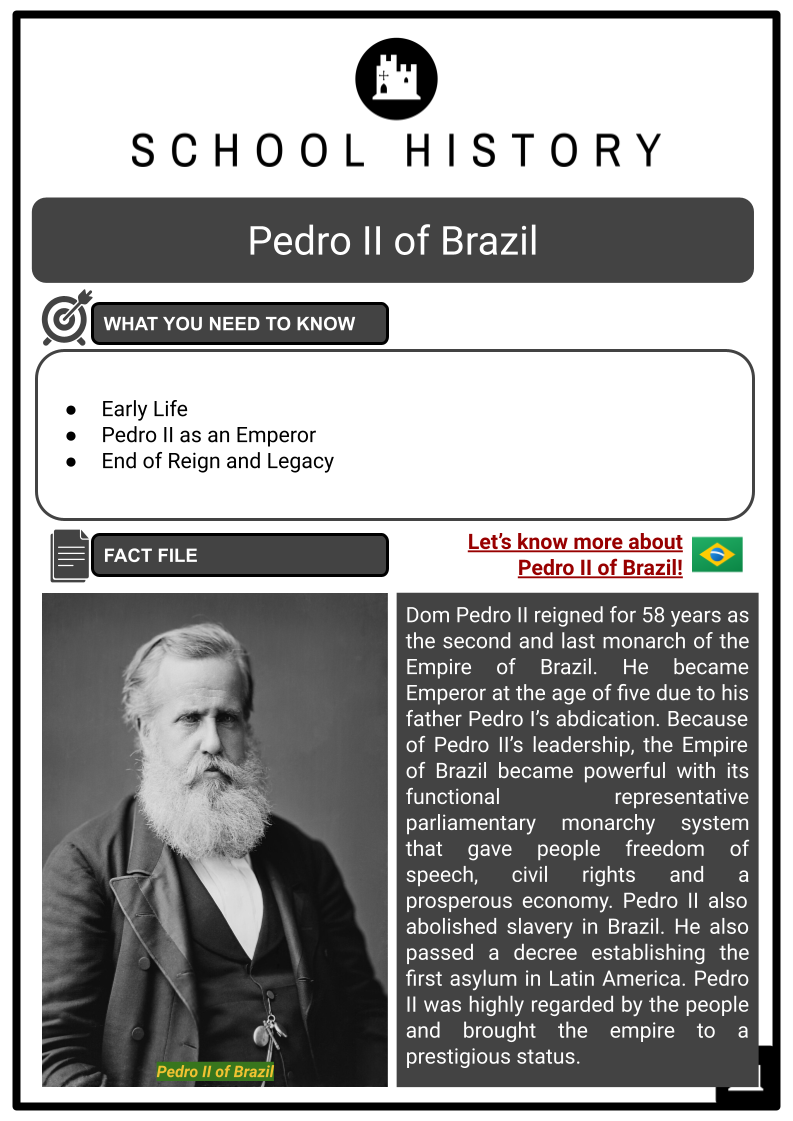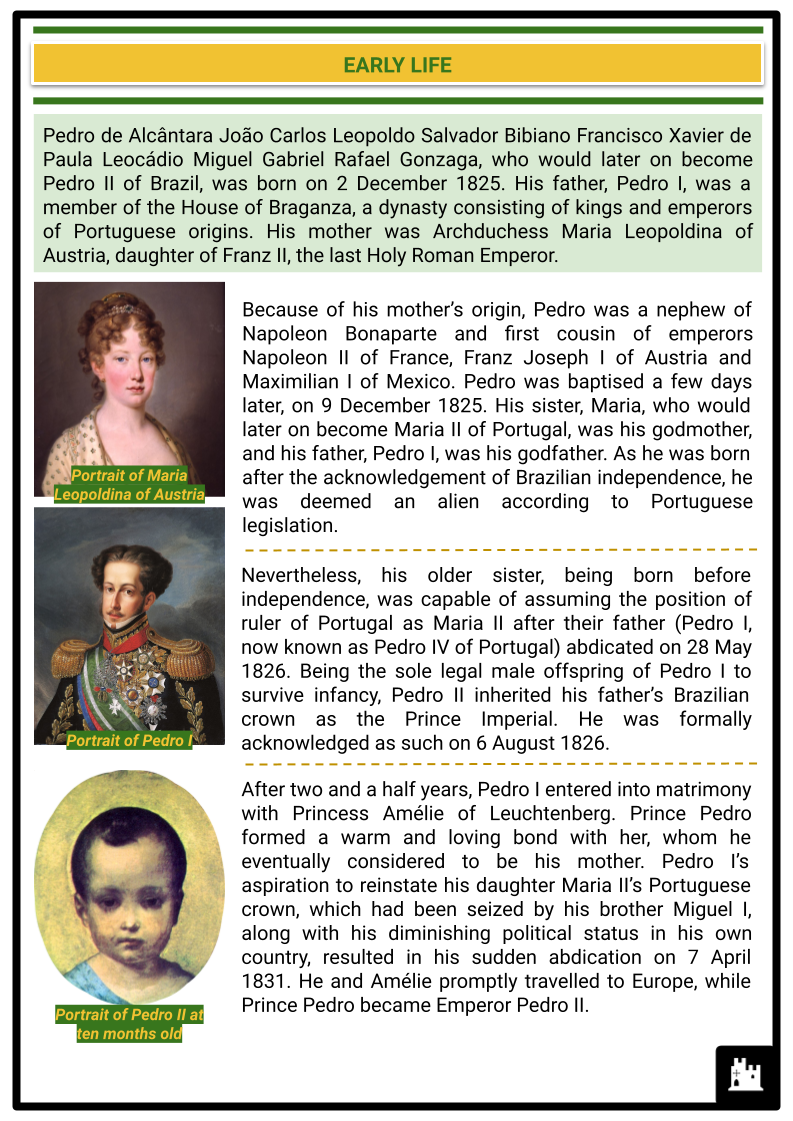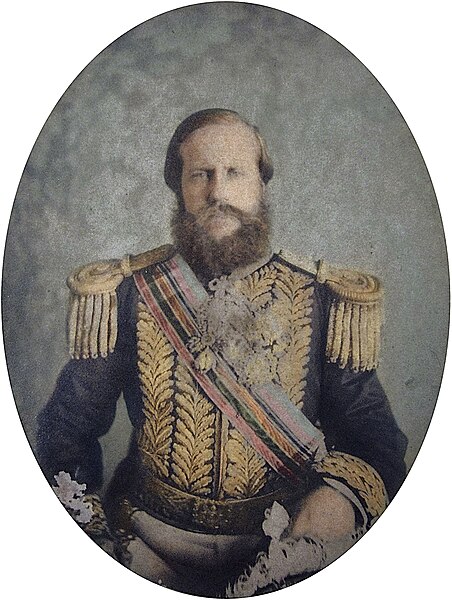Pedro II of Brazil Worksheets
Do you want to save dozens of hours in time? Get your evenings and weekends back? Be able to teach about Pedro II of Brazil to your students?
Our worksheet bundle includes a fact file and printable worksheets and student activities. Perfect for both the classroom and homeschooling!
Resource Examples
Click any of the example images below to view a larger version.
Fact File


Student Activities




Summary
- Early Life
- Pedro II as an Emperor
- End of Reign and Legacy
Key Facts And Information
Let’s know more about Pedro II of Brazil!
Dom Pedro II reigned for 58 years as the second and last monarch of the Empire of Brazil. He became Emperor at the age of five due to his father Pedro I’s abdication. Because of Pedro II’s leadership, the Empire of Brazil became powerful with its functional representative parliamentary monarchy system that gave people freedom of speech, civil rights and a prosperous economy. Pedro II also abolished slavery in Brazil. He also passed a decree establishing the first asylum in Latin America. Pedro II was highly regarded by the people and brought the empire to a prestigious status.

EARLY LIFE
- Pedro de Alcântara João Carlos Leopoldo Salvador Bibiano Francisco Xavier de Paula Leocádio Miguel Gabriel Rafael Gonzaga, who would later on become Pedro II of Brazil, was born on 2 December 1825. His father, Pedro I, was a member of the House of Braganza, a dynasty consisting of kings and emperors of Portuguese origins. His mother was Archduchess Maria Leopoldina of Austria, daughter of Franz II, the last Holy Roman Emperor.
- Because of his mother’s origin, Pedro was a nephew of Napoleon Bonaparte and first cousin of emperors Napoleon II of France, Franz Joseph I of Austria and Maximilian I of Mexico. Pedro was baptised a few days later, on 9 December 1825. His sister, Maria, who would later on become Maria II of Portugal, was his godmother, and his father, Pedro I, was his godfather. As he was born after the acknowledgement of Brazilian independence, he was deemed an alien according to Portuguese legislation.
- Nevertheless, his older sister, being born before independence, was capable of assuming the position of ruler of Portugal as Maria II after their father (Pedro I, now known as Pedro IV of Portugal) abdicated on 28 May 1826. Being the sole legal male offspring of Pedro I to survive infancy, Pedro II inherited his father’s Brazilian crown as the Prince Imperial. He was formally acknowledged as such on 6 August 1826.
- After two and a half years, Pedro I entered into matrimony with Princess Amélie of Leuchtenberg. Prince Pedro formed a warm and loving bond with her, whom he eventually considered to be his mother. Pedro I’s aspiration to reinstate his daughter Maria II’s Portuguese crown, which had been seized by his brother Miguel I, along with his diminishing political status in his own country, resulted in his sudden abdication on 7 April 1831. He and Amélie promptly travelled to Europe, while Prince Pedro became Emperor Pedro II.
- Pedro I chose three people to supervise Pedro II and the rest of his children. The first was José Bonifácio de Andrada, an influential leader during Brazilian independence, who was designated as the guardian. Next was Mariana de Verna, who had held the post of governess since Pedro II’s birth. Lastly was Rafael, an employee in the Palace of São Cristóvão, whom Pedro I deeply trusted.
- In 1833, Bonifácio was dismissed from his position and replaced by another guardian. As a young emperor, Pedro II spent most of his time studying and never had the chance to spend much time with his friends and sisters. For some politicians, Pedro II was too young to govern the Empire of Brazil despite having the title of Emperor. As a result, a regency was assigned to govern on his behalf, but it was faced with political conflicts and rebellions.
- Due to ongoing political factions and rebellions, the government decided to abolish the regency and transfer all the political powers to Pedro II, despite his age. The abolishment of the regency resulted in the dissolution of political factions and political stability within the Empire. Pedro II became the main political figure in the Empire of Brazil and was acknowledged as the legitimate source of power.
- Shortly after Pedro II gained legitimacy as an emperor, a wedding was arranged for him and Princess Teresa Cristina of the Kingdom of the Two Sicilies. A proxy represented Princess Teresa during the wedding on 30 May 1843. Some accounts stated that Pedro II was disappointed when he saw Princess Teresa in person. Roderick J. Barman, a member of the history department at the University of British Columbia, mentioned in his work that the princess was short, overweight and not considered conventionally pretty. A Nuptial Mass took place to approve the vows of the couple and grant the nuptial blessing.

PEDRO II AS AN EMPEROR
- Despite being married, Pedro II was busy travelling around the empire. He was easily accepted by the people because of his good character. He was polite and never lost patience when talking to ordinary people. Despite this warm welcome, Pedro II was not spared from political issues. He faced three crises between 1848 and 1852.
- First, he was confronted with the issue of illegal trafficking of imported enslaved people. In 1826, as a result of an agreement with the United Kingdom, importing of enslaved people was prohibited.
- Despite ongoing efforts to combat it, trafficking persisted, and the British government enacted the Aberdeen Act of 1845, granting British warships the authority to inspect Brazilian vessels and confiscate those engaged in the slave trade.
- As Brazil dealt with this issue, Pedro II faced the second crisis when the Praieira uprising broke out on 6 November 1848. This war arose from the rivalry between different political groups in the province of Pernambuco. It was brought under control by March 1849. A year after, the issue of illegal trafficking was also addressed when the Eusébio de Queirós Law was enacted on 4 September 1850. The law granted the Brazilian government extensive powers to suppress the illicit slave trade.
- The third crisis involved a dispute with the Argentine Confederation about control of areas along the Río de la Plata and unrestricted transportation of that waterway. Starting in the 1830s, the Argentine tyrant Juan Manuel de Rosas assisted rebellions in Uruguay and Brazil. Not until 1850 did Brazil manage to confront the menace presented by Rosas. Brazil’s adept handling of these crises significantly bolstered the country’s stability and reputation, establishing it as a dominant force in the hemisphere.
- Pedro II possessed the characteristics of neither a British-style figurehead nor an authoritarian like the Russian czars. The emperor wielded authority by collaborating with elected officials and economic stakeholders and garnering public endorsement. Pedro II’s active involvement in politics played a crucial role in the government’s framework, which comprised the cabinet, the Chamber of Deputies and the Senate (the latter two together forming the General Assembly).
- The Chamber of Deputies functioned as the governing body of the nation, but Pedro possessed a vague poder moderador, sometimes known as the ‘moderation power’. This meant that he could influence existing legislation but lacked the authority to introduce new legislation himself. Pedro II exercised his authority wisely, and the rival groups in the legislature were so quarrelsome that he was able to effectively exert significantly more power than he was believed to possess.
- Pedro consistently prioritised the interests of Brazil, basing his decisions on what he believed to be most advantageous for the nation. Even individuals who strongly opposed monarchy and the empire eventually developed a personal admiration for him.
War of the Triple Alliance
- Pedro experienced his most challenging moments during the catastrophic War of the Triple Alliance (1864–1870). For many years, Brazil, Argentina and Paraguay engaged in military and diplomatic conflicts over Uruguay’s control while politicians and political parties in Uruguay manipulated their larger neighbouring countries against each other.
- Despite being significantly outnumbered, the Paraguayan army successfully resisted the three opposing countries for two years. In 1868, the Empire of Brazil successfully annihilated the Paraguayan army, resulting in the death, injury or capture of over 10% of the small country’s people. However, Paraguayan guerrilla forces persisted in their fight for a further two years while Brazilian officials grew increasingly exasperated with the financial burden of a conflict that lacked clear objectives.
- Although Brazil successfully disbanded the Paraguayan army and established its supremacy in the region, it derived minimal benefits from this triumph. Similar to previous conflicts after gaining independence, the war was funded by the Bank of London. As a result, Brazil became even more indebted to the British and more subservient to their trading and political agendas. Pedro II endured a more severe setback than any individuals involved in the war.

- The Paraguayan soldiers were captured by a significant number of troops in the Brazilian army, a considerable portion of whom had been emancipated from slavery in return for their military service. The Paraguayan army regarded their adversaries as racially subordinate, referring to Black soldiers as ‘monkeys’ and labelling Pedro II as ‘El Macacón’ (the Great Ape). Following the war, troops who had fought alongside formerly enslaved people encountered challenges in accepting the reinstatement of slavery.
- A greater number of emancipated enslaved people existed. These elements would have an impact in the following decades, contributing to the long process of eliminating slavery. While Brazil technically achieved a decisive victory in the Paraguayan War, it did not succeed in alleviating the country’s long-standing state of decline. The war had a detrimental impact on Brazil’s reputation, both domestically and internationally, in Europe and the United States. The popularity of Pedro II, which had declined during the prolonged struggle, swiftly rebounded following the ultimate triumph.
Prestige of Pedro II
- When the Paraguayan War ended, the Brazilian Empire experienced a ‘golden age’. The 1870s served as a period of prosperity for the empire because of significant changes in the social and political spheres, which resulted in a more equitable distribution of the nation’s riches. The economy was experiencing rapid growth, and various plans for domestic progress, such as the construction of railroads, shipping lines and immigration colonies, were becoming increasingly common. Given the inevitable decline of slavery and the anticipated implementation of other reforms, the potential for significant progress in both moral and material aspects appeared immense.
- Aside from economic prosperity, the empire intensified its commitment to ending slavery by passing the Rio Blanco Law, commonly known as the Law of Free Birth, in 1871. The empire enacted the law to free those children born to enslaved women, meaning no children were born enslaved. Later, through manumission and emancipation laws, enslaved people were given their freedom.
First Brazilian Psychiatry
- Among Pedro II’s legacy was the establishment of the first Brazilian psychiatry institution in the city of Rio de Janeiro. Officially, the foundation occurred through the number 82 decree on 18 July 1841, the first day of Pedro II’s coronation ceremony. Since its establishment, the Pedro II Asylum became a symbol of the monarchy’s power and Brazilian civilisation. Following Rio de Janeiro’s establishment as the Crown’s focal point, there was a rise in street poverty and an increase in the city’s population. The streets were populated by beggars, vagabonds, drunkards, and individuals who had mental illnesses.
- Prior to medical and social advancements, individuals were only apprehended when displaying hostile behaviour. However, following these advancements, they began to be categorised into two groups: those requiring medical assistance and those who did not. The group consisting of individuals who were intoxicated or mentally unstable was transferred to the Santa Casa de Misericórdia do Rio de Janeiro. Unfortunately, the institution was insufficient in size to accommodate the large influx of patients, resulting in unsanitary conditions.
- If patients were part of an affluent socioeconomic class, their families would be responsible for providing them with care either at home or in a specialised facility. The Pedro II Asylum’s statute was officially established by decree number 1077, which was published on 4 December 1852. The next day, the first mental institution in Brazil, with a maximum capacity of 350 patients, was inaugurated. The financial backing originated from the empire itself, the lottery, contributions, philanthropy and certain patients’ fees.
END OF REIGN AND LEGACY
- The push for democratisation in Brazil gained momentum during the 1880s. Pedro II commanded the respect of all, even those who opposed him. While his foes despised the empire, they yearned for change. Following the eradication of slavery, the country experienced heightened polarisation. The military intervened and deposed Pedro from power in November 1889.
- After enduring the insult of being confined to his palace, he was eventually urged to go into exile. He departed on 24 November. He travelled to Portugal and resided in an apartment, receiving a continuous flow of friends and well-wishers until his demise on 5 December 1891. Despite being only 66 years old, his extensive tenure in office spanning 58 years had prematurely aged him.
- Pedro II was a highly esteemed ruler of Brazil. His unwavering commitment, integrity and adherence to ethical principles ensured the stability and unity of his nation for more than five decades while neighbouring South American countries experienced disintegration and engaged in conflicts.
- Pedro excelled as a ruler despite his lack of inclination for it: he often expressed his preference for becoming a teacher rather than an emperor. He guided Brazil towards modernisation while maintaining a strong sense of moral responsibility. He made significant sacrifices for his country, relinquishing his aspirations and well-being.
- Upon being removed from power, he expressed his willingness to depart if the citizens of Brazil no longer desired him as their ruler, and true to his word, he promptly left, possibly feeling a sense of relief. Upon the establishment of the new republic in 1889, Brazil experienced challenges and difficulties. Consequently, the citizens of Brazil really felt the absence of Pedro and yearned for his return. Upon his demise in Europe, Brazil entered a state of mourning for one week despite the absence of an official holiday.
- Today, Brazilians hold a strong and affectionate memory of Pedro, bestowing upon him the appellation ‘the Magnanimous’. The remains of both him and Teresa Cristina were repatriated to Brazil in 1921 amid a grand celebration. A large number of Brazilian citizens, a significant portion of whom had vivid recollections of him, gathered in great numbers to greet his remains upon his return to the country. He is often regarded as one of the most eminent Brazilians in history.
Frequently Asked Questions
- Who was Pedro II of Brazil?
Pedro II was Brazil's second and last Emperor, reigning from 1831 until his deposition in 1889. His full name was Dom Pedro II, and he was the son of Dom Pedro I, the founder and first Emperor of Brazil.
- How did Pedro II become Emperor of Brazil?
Pedro II became Emperor after his father, Pedro I, abdicated on 7 April 1831. He was only five years old then, so a regency was established until he was declared of age in 1840 at 14.
- What were some notable achievements during Pedro II's reign?
During Pedro II's reign, Brazil saw significant progress in various fields, including:
- Abolition of slavery in 1888.
- Expansion of infrastructure such as railways and telegraphs.
- Promotion of arts, science, and education.
- Establishment of stable political institutions.
